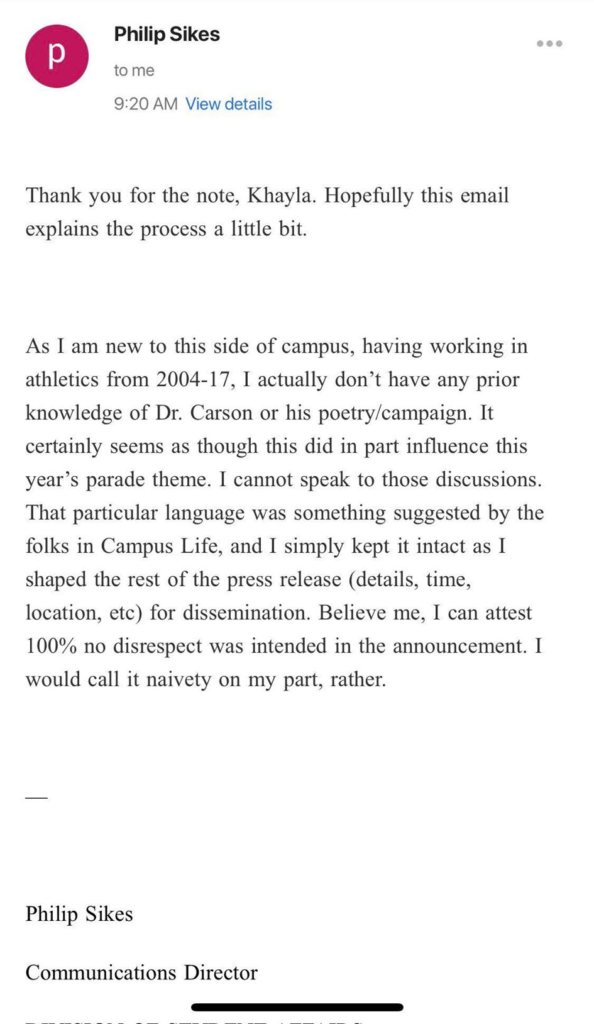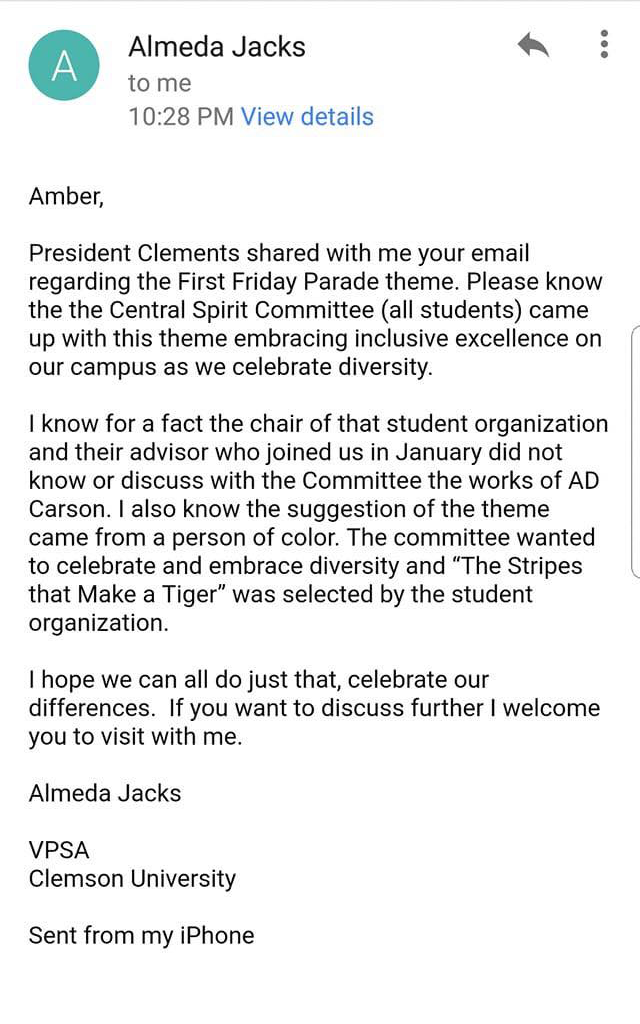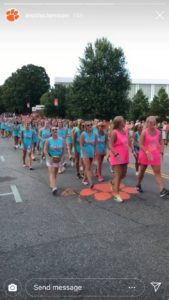
29 Aug Pimping the Stripes: When Universities Use PR to Avoid the Radical Work of Diversity and Inclusion
A group of former and current Clemson students and faculty recently learned that Clemson University has chosen a theme of diversity for its First Friday Parade. The theme is “The Stripes That Make a Tiger,” which is described, “Just as a tiger is not complete without its stripes, the Clemson family is not complete without the diverse experiences and contributions of students and alumni.”
On the surface a move like this by Clemson’s administration appears to be a step forward. It could be seen as a form of “getting out in front of diversity.”
As a student in Clemson University’s Rhetorics, Communication, and Information Design doctoral program I wrote a poem and initiated a campaign called “See the Stripes” in an attempt to raise awareness about commonly overlooked contributions to the university’s history. [The overview of that campaign can also be read here.] Something about Clemson’s use of the language and concept behind the See the Stripes campaign in a self-congratulatory parade wasn’t sitting quite right. It seems that the diversity they will be celebrating comes at the cost of erasing the “diverse experiences and contributions of” the recent students and alumni from whom they have plagiarized their theme.
In light of this, I thought I would share my concerns for those struggling within and around Clemson and other institutions that are dealing with the challenges and ideological uses of diversity and inclusion.
I am certainly in support of the diverse students at Clemson who are working to survive and prevail in that environment. To the students, I appreciate that you have not forgotten, and if anyone “owns” See the Stripes it is you along with others who continue to struggle toward a radical transformation of Clemson and other institutions. In that vein, I encourage you to use the thoughts expressed here to do what the Clemson administration is unwilling to do.
Whenever I see university diversity initiatives, I think back to the afternoon of Thursday, April 14th, 2016, the second day of the #SikesSitIn.
I stood with four other students in the lobby of Sikes Hall, the university’s administration building. We were protesting Clemson’s lack of progress on a variety of reasonable diversity demands, and we had refused to leave.
With a Clemson police officer by her side, Vice President of Student Affairs Almeda Jacks stood in front of each one of us threatening us to get us to leave the building and end our protest.
Hundreds of supportive students and faculty waited outside.
She reminded me that an arrest record would threaten my future job prospects. For undergraduate protesters she warned us that standing their ground would ruin their careers. Her face indicated a stern willingness to use her own influence to make good on her threats.
The only thing that exceeded our collective anger at this was the disappointment that Clemson’s leadership would resort to such dishonorable and petty tactics.
We did not leave and were arrested and charged with trespassing.
During the years I attended Clemson there were a number of events that ultimately brought us together on the front steps of Sikes Hall. The primary reason we participated in the #SikesSitIn was because the grievances, which were expressed in the previous years leading up to it, went mostly unacknowledged, and the demands continued to go unfulfilled. Shortly after we suspended the sit-in, Clemson’s president Jim Clements finally issued a statement in response to those grievances and demands.
There are people whose primary job at the university is to work with students toward a goal like “diversity” or “inclusion.” Letting students lead doesn’t mean that highly paid administrators should use their unpaid student creativity and labor to sanitize Clemson’s public image.
In appropriating the See The Stripes campaign, which called for action to change the conditions at the university, Clemson turned it into an empty slogan, a theme for a parade that signifies they’ve actually taken action and changed those conditions without acknowledging any of the work. They don’t mention the work of the student activists from whom they borrow the language. They don’t mention the grievances that spawned the work of the students. They don’t mention the demands issued by the students. And they don’t mention what actual work the university has done to address those grievances and demands.
Worse than plagiarism, of which I’m fairly certain it is, the parade theme is not tethered to anything tangible that can be called “diversity” or “inclusion” other than the appearance of such. It even undermines itself, as it is borrowed from previous students and alumni, unattributed, and claims “the Clemson family is not complete without the diverse experiences and contributions of students and alumni.” What’s most telling is that by that logic the so-called Clemson family will never be complete, which is exactly why students, past and present, have expressed the aforementioned grievances.
Members of the community emailed Clemson about the press release and Philip Sikes, Communications Director, responded that he didn’t have any prior knowledge of the poem or campaign, but that “it certainly seems as though this did in part influence this year’s parade theme.” Vice President of Student Affairs Almeda Jacks, the same Vice President of Student Affairs who had us arrested, plead ignorance as well. She took it a step further, though, insinuating that because a “student of color” was involved in the choosing of the theme Clemson should be shielded from critiques that the theme might generate. My email to Mr. Sikes received a response from Associate Vice President and Dean of Students, Chris Miller – a message to call him – but the phone number was to a furniture store in Rantoul, IL. I emailed back to let him know and never received a follow-up.


To address the inevitable, “what is Clemson supposed to do?” questions, and “Clemson is not perfect but we’re trying” dismissals of this critique, here are few points that can help Clemson evaluate the substance of its efforts.
- See the Stripes is not simply a slogan. It represents a movement, a set of demands, and ongoing historical context.
- Clemson University has consistently failed to meet those demands. Clemson is at or near the bottom of nearly every measure of diversity. In 2017, a year when Clemson claimed that retention of faculty of color was a priority Clemson lost 4 faculty of color to other universities. Three of those faculty cited Clemson’s oppressive approach to diversity as reasons why they left. When asked about this, the diversity office could not name them.
- One or two-day conferences, or lecture series only scratch the surface of what it is needed. Despite the positive (and deceptive) publicity that these create, they do not transform Clemson at a fundamental level. For a more developed program, Clemson must revisit the original See the Stripes demands, honor any additions to those demands by current students, and be held accountable.
- Clemson has deceived, denounced, and arrested students and faculty who have tried to push the University toward inclusive excellence. In 2016, student protesters lost job opportunities due to a (temporary) criminal record that was given to them.
- There are people whose primary job at the university is to work with students toward a goal like “diversity” or “inclusion.” Letting students lead doesn’t mean that highly paid administrators should use their unpaid student creativity and labor to sanitize Clemson’s public image.
- Clemson Administrators must come clean about their past and ongoing failures. Wounds cannot heal while they are still being inflicted. As much or more energy should be placed into such acknowledgements.
- Clemson must find the courage to educate politicians, alumni, and anyone else who is resistant to the change that must come rather than ignoring and denouncing the current students and alumni who are encouraging the necessary change.
When I graduated from Clemson I was proud because I thought my work could make a difference, could maybe help amplify some questions about universities, knowledge production, and academic engagement. Clemson also celebrated this work. “See the Stripes” was one of the tracks on my dissertation album, which raises the aforementioned questions, among many. Another is this, asked by Alexander Weheliye in Phonographies: Grooves in Sonic Afro-Modernity, “what happens once the black voice becomes disembodied, severed from its source, [re]contextualized, and [re]embodied and appropriated, or even before this point?” [37] Clemson’s rebranding of the “See The Stripes” campaign, re/depoliticizing it, and parading it as “The Stripes That Make a Tiger” without any acknowledgment might be offered as yet another response to that question.
On that album there is also a song called “Grading On A Curve” on which I rap,
“I could write a thesis just to teach that it’s there.
But you could likely see the same aggrievements I’d prepare,
‘cause that’s what people do when people care.
But you stay in set your positions.
Don’t want to change the world, so you change the definitions,
pretend the world that I describe is not the world you live in,
but still you’d like to hear from me forgiveness?”
When institutions claim to be doing the work of diversity and inclusion, but they use that work against their “diverse” student populations, then they aren’t doing the work they claim they’re doing. You can’t simply change the stripes on a tiger and call it by another name. If they can, and that’s how the institution is designed to work, then it’s far past time we rethink what we claim to be our duty.

Community at Sikes Hall during the #SikesSitIn | Photo from The Tiger newspaper.
At the parade:
In a Facebook post, Pauline Matthey writes:
“Theme of the First Friday Parade at Clemson University:








Brandi Rios
Posted at 05:41h, 12 AprilThank you for posting
Clemson University parade theme criticized for co-opting student movement
Posted at 00:56h, 07 September[…] other than the appearance of such,” A. D. Carson, a former graduate student at Clemson, wrote in a blog post. “It even undermines itself, as it is borrowed from previous students and alumni, unattributed, […]
Your 3rd Fl Cooper Coffee Companion ;)
Posted at 19:43h, 31 AugustYeah, Communications had no idea about your dissertation topic… Please tell me you have hired an attorney.